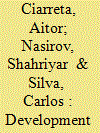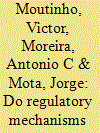|
|
|
Sort Order |
|
|
|
Items / Page
|
|
|
|
|
|
|
| Srl | Item |
| 1 |
ID:
149983


|
|
|
|
|
| Summary/Abstract |
This paper provides a comprehensive analysis of the market power problem in the Spanish power generation sector and examines how and to which extent the market has developed in terms of market power concerns after the market liberalization reforms. The methodology applied in this study includes typical ex-post structural and behavioral measures employed to estimate potential for market power, namely: concentration ratios (CR) (for the largest and the three largest suppliers), the Herfindahl–Hirschman Index (HHI), Entropy, Pivotal Supply Index, the Residual Supply Index and Residual Demand Elasticity (RDE). The results are presented for the two largest Spanish generating companies (Endesa and Iberdrola) acting in the Iberian Electricity Market (MIBEL), and in the Spanish Day-ahead electricity market. The results show evidence that these companies have behaved much more competitively in recent periods than in the beginning of the market liberalization. In addition, the paper discusses important structural and regulatory changes through market liberalization processes in the Spanish Day-ahead electricity market.
|
|
|
|
|
|
|
|
|
|
|
|
|
|
|
|
| 2 |
ID:
133213


|
|
|
|
|
| Publication |
2014.
|
| Summary/Abstract |
This paper estimates the relationships between bidding quantities, marginal cost and market power measures in the Spanish wholesale electricity market for two different regulatory periods: 2002-2005 and 2006-2007. Using panel econometric techniques we find differences in the impacts on bidding strategies for both periods. Hence, the marginal cost and the market power measures affect bid and net quantities. The market power measures also suggest that the coefficient is consistently positive and highly significant for both periods.
Moreover, the market power and marginal costs have mixed effects according to the models proposed for both periods. In addition, our results point to the effectiveness of the different effects of mitigating the market power in the Spanish electricity market. For the 2006-2007 period, the proposed causal relationships are partially validated by the cointegration results, which assumes there is a significant causality between the Lerner Index and the marginal cost.
|
|
|
|
|
|
|
|
|
|
|
|
|
|
|
|
| 3 |
ID:
132655


|
|
|
|
|
| Publication |
2014.
|
| Summary/Abstract |
Renewable energy promotion and its cost are at the heart of the energy policy debate in many countries. The question from an economic perspective is how expensive the promotion of renewable sources through price-based incentive schemes is. This paper addresses this issue empirically. We analyze the Spanish electricity market during the period 2008-2012, where renewable energy production rose by 57%. To determine how expensive it was, we first measure the savings due to the spot price reduction driven by the merit order effect and, second, we compute the amount paid as incentives to green energy by the electricity system; the difference between the two is the net cost of green energy to the electricity markets. We present aggregate results for renewable sources as a whole, as well as individual results for each technology. We show that at the initial stages, when renewable capacity was low, green energy promotion paid for itself (2008-2009); however, from 2010 on, when renewable production reached a relatively high level, it started to impose a positive net cost on the system. Finally, we found substantial differences among technologies: wind energy implied the lowest net cost, while solar photovoltaic was the most expensive.
|
|
|
|
|
|
|
|
|
|
|
|
|
|
|
|
|
|
|
|
|